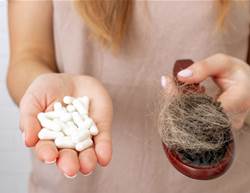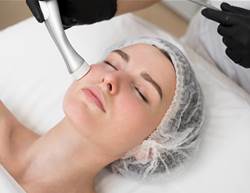‘Natural’ is the buzzword for 2023, so it’s nice knowing there are effective ways to improve the quality of your skin and enhance your bare-faced beauty. Cut down your makeup usage and let your skin breathe by letting active ingredients do the work of helping you take care of it. This means checking your skincare regularly to make sure it's still doing its job, using active ingredients to protect your skin against outbreaks that have you reaching for a concealer and investing in facial treatments to give your complexion a boost.
When GOOD skincare goes bad
If you’re the sort of person who likes to savour a skincare product, you’re not alone. Those bottles can be pricey – of course you want them to go the distance. The trouble is many ingredients don’t have a long shelf life. Once exposed to water, air, light or bacteria, they start to degrade. Indeed, one study found products containing vitamin C, CoQ10 or retinol lost 40 per cent of their active concentrations in eight weeks.
So, what’s the fix? Clinical skin specialist Douglas Pereira says the secret to getting the most from active products is to use them generously. “Once the bottle is opened, treat it like prescribed medication – using the correct amount is imperative to achieving results,” he says.
Formulation is also key. “Certain active ingredients that provide great skin benefits, like L-ascorbic acid (vitamin C), can be difficult to keep stable. A more superior form of vitamin C, called ascorbyl tetraisopalmitate, has greater longevity and effectiveness when formulated correctly.” So, pay attention to the ingredients and be mindful of use, expiry and storage, too.
How to get the most out of your actives
✗ Don’t touch droppers on your skin; use a cotton bud instead to avoid putting fingers in a jar.
✔ Look for single-dose systems, such as airless pumps, which will help protect your skincare from light and bacteria.
✔ If something has lost its potency, there’s no need to chuck it. Simply use it elsewhere on your body, like your hands, arms and décolletage.
Spot the difference
Still dealing with spots in your 30s and 40s? You’re not alone. About 35 per cent of women aged 30–39 and 26 per cent aged 40–49 deal with acne outbreaks, which are often hormonal, says GP Dr Ginni Mansberg, a member of the Australasian Menopause Society.
“Women going through perimenopause have higher cortisol levels linked to worse acne,” she explains. “Stress can also cause breakouts.” While some types of hormonal acne may require medical intervention, there’s a new generation of skincare products that target spots with ease. Dissolving microneedle patches (such as ESK Spotless Microneedle Patches) deliver powerful active ingredients beneath the skin’s surface to reduce spots overnight.
What can help?
La-Roche Posay’s Effaclar range includes salicylic acid-bolstered skincare that helps reduce breakouts while boosting skin health and hydration. And Dermalogica Post-Breakout Fix helps minimise those dark marks left behind after a pimple heals, known as post-inflammatory pigmentation, ensuring spots are a distant memory.
To keep breakouts at bay, Dr Mansberg advises looking for products containing these smart ingredients:
Retinal: Twenty times more powerful than its cousin, retinol, this form of vitamin A is well
tolerated by sensitive skin and is proven to treat acne.
Salicylic acid: With a track record for spot-clearing, this beta hydroxy acid has exfoliating, anti-inflammatory and anti-microbial properties.
Niacinamide: Also known as vitamin B3, it’s not only anti-inflammatory but reduces pimples and oil production, too.
Facial off
Once again, science brings us another way to push it a bit further when it comes to skincare. Some of the best in-salon facials use active ingredients customised to your skin concerns, high-tech clinical devices that kickstart new collagen formation to reduce wrinkles, and deep cleansing that instantly resurfaces and smooths the skin. It’s a fast track to a brighter complexion and increased confidence.
“My patients are mainly 40 and what many of them really want is to improve the quality of their skin,” says Dr David Kosenko, president of the Cosmetic Physicians College of Australasia. “They want less redness, less pigmentation, smaller pores and have skin that ‘glows’. My prediction is that, as their age increases, they’ll prefer procedures that make their skin appear healthier, with fewer blemishes while still looking natural.”
Curious? Try one of these treatments:
Hydrafacial
Thirty minutes is all it takes for this treatment, which deeply cleanses, exfoliates, moisturises and infuses your skin with a cocktail of antioxidants and peptides for noticeable natural radiance.
Cynosure Ultracel Q+
This high-intensity focused ultrasound (HIFU) treatment raises the heat of skin tissue to boost collagen, reduce skin laxity and eliminate stubborn fat cells, to leave you looking smooth and fresh. It takes a few weeks for full results to kick in, so plan ahead.
Learn more about Cynosure Ultracel Q+
Dermalogica Proskin Treatment
This 30- or 60-minute facial is fully customised to your skin’s needs, incorporating everything from professional-grade peels and actives to hydradermabrasion, LED light therapy and ultrasound infusion.










